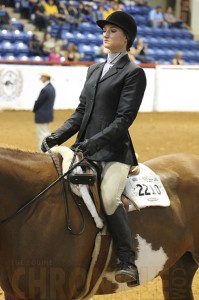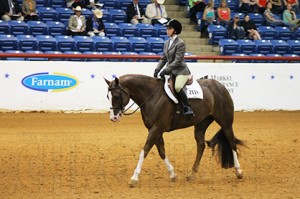Youth World Prep: “Riders, Drop Your Stirrups”
By: Brittany Bevis
There is a moment in every equitation or horsemanship class that most competitors dread. The announcer’s call for riders to drop their stirrups will come to the dismay of those who haven’t properly prepared, however, it’s often met with a unanimous cheer of approval from the audience.
In theory, it seems like a relatively simple command. For the elite competitors that will be putting their skills on display at the AQHA Youth World Show later this week, preparation for this part of the class should have happened many months in advance.
We sought out the expertise of AQHA horse trainer Scott Jones to find out some of the more common mistakes riders make when dropping their stirrups and simple ways to perfect leg position.
“The best way to get really good at working with no stirrups is to work with no stirrups, a lot,” Jones says. “I find that a lot of riders either shorten their legs up too much or they lengthen their legs too much and they don’t keep their legs wrapped around their horse.”
“Honestly, the more you do it, the better you get at it. For our really good equitation riders, we take their stirrups completely away for the month before a horse show, and we start to give them back as the show gets closer. As a result, they have to get really strong in their legs to be able to hold their position at a sitting trot, posting trot, canter, and changing leads without stirrups.”
In the end, it’s a rider’s ability to maintain the same position without stirrups that can mean the difference between a first place or third place finish. In addition, Jones emphasizes that leg contact should be maintained from thigh to knee to calf and lower leg, whether stirrups are in place or not.
“Basically, when you take a rider’s stirrups away, they still have to stay low in the heel while wrapping their legs around the horse,” he says. “The biggest part of that is you still have to keep your legs close to the horse, but you don’t have your stirrups to press into. Some riders [compensate] by shortening their legs up or lengthening out too far.”
“When you sit and watch a class of riders ride without stirrups, I want it to look like nothing has changed, because their position is essentially the same. It shouldn’t look like a struggle. It should look easy. Again, the best way to do that is to take stirrups away and not give them back for a long period of time.”
Even the most seasoned riders rely on this strategy to maintain equitation excellence.
“Even the Olympic riders go through daily longe line lessons, without stirrups and without reins, to keep themselves more in tune with their horses,” Jones says. “We’ve done a lot of longe line lessons [without stirrups] so the kids don’t have to worry about steering. They can focus on holding their legs in the proper position and not worry about where they’re going. You can also do it in a round pen.”
There is the matter of personal preference that comes into play when discussing whether the direction of a rider’s post should be more of an up and down motion or a forward and back motion. If a rider hasn’t prepared well beforehand for the “no stirrups” call, a lack of leg strength will make a weak post look even more awkward.
“You need to be able to give in to both,” Jones says. “For us, we don’t want to see too much of an up and down motion. If you’re going forward on a hunter/jumper or hunt seat horse, you should allow for that movement and should be able to post more forward to stay with your horse. It shouldn’t be a straight up and down motion, necessarily.”
For all of the riders headed to the AQHA Youth World Show later this week, be sure to get in a few more days of practice before the “no stirrups” call comes a calling.












